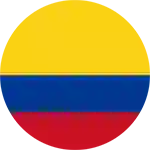Colombia
-- Republic of Colombia --
Colombia officially the Republic of Colombia is a unitary, constitutional republic comprising thirty-two departments. It is located in northwestern South America, bordered to the northwest by Panama; to the north by the Caribbean Sea; to the east by Venezuela and Brazil; to the south by Ecuador and Peru; and to the west by the Pacific Ocean. The territory of what is now Colombia was originally inhabited by indigenous peoples including the Muisca, Quimbaya, and Tairona.
Colombia is ethnically diverse, and the interaction between descendants of the original native inhabitants, Spanish colonists, Africans originally brought to the country as slaves, and 20th-century immigrants from Europe and the Middle East, has produced a rich cultural heritage. This has also been influenced by Colombia's varied geography, and the imposing landscape of the country has resulted in the development of very strong regional identities, in many cases stronger than the national. The majority of the urban centres are located in the highlands of the Andes mountains, but Colombian territory also encompasses Amazon, tropical grassland and both Caribbean and Pacific coastlines.
-- Economy --
Historically an agrarian economy, Colombia urbanised rapidly in the 20th century, by the end of which just 22.7% of the workforce were employed in agriculture. Colombia's market economy grew steadily in the latter part of the 20th century, with gross domestic product (GDP) increasing at an average rate of over 4% per year between 1970 and 1998.
Colombia is rich in natural resources, and its main exports include petroleum, coal, gold, precious stones, nickel, forest products, pulp and paper, coffee, sugarcane, cereals and vegetable oils, cotton, rice, soy beans, oilseed, tropical treetops, tobacco, fruit and other agricultural products, food processing, processed fish products, beverages, machinery, electronics, military products, aircraft, ships, motor vehicles, metal products, ferro-alloys, boilers, home and office material, chemicals and health related products, petrochemicals, inorganic salts and acids, agrochemicals, perfumery and cosmetics, medicaments, plastics, animal fibers, textile and fabrics, clothing and footwear, leather, construction equipment and materials, cement, software, among others.
Colombia is also known as the world's leading source of emeralds, while over 70% of cut flowers imported by the United States are Colombian.[81] Principal trading partners are the United States, theEuropean Union, Venezuela and China.[12] All imports, exports, and the overall balance of trade are at record levels, and the inflow of export dollars has resulted in a substantial re-evaluation of the Colombian peso.
-- Politics --
The government of Colombia takes place within the framework of a presidential representative democratic republic as established in the Constitution of 1991. In accordance with the principle of separation of powers, government is divided into three branches: the executive branch, the legislative branch and the judicial branch.
As the head of the executive branch, the President of Colombia serves as both head of state and head of government, followed by the Vice President and theCouncil of Ministers. The president is elected by popular vote to serve four-year terms and is limited to a maximum of two such terms (increased from one in 2005). At the provincial level executive power is vested in department governors, municipal mayors and local administrators for smaller administrative subdivisions, such ascorregidores or corregimientos.
Colombia was one of the 12 founding members of the UNASUR, which is supposedly modeled on the European Union having free trade agreements between the members, free movement of people, a common currency, and also a common passport. Colombia is a member of the Andean Community of Nations, the Pacific Alliance and the Union of South American Nations. Colombia is divided into 32 departments and one capital district, which is treated as a department (Bogotá also serves as the capital of the department of Cundinamarca). Departments are subdivided intomunicipalities, each of which is assigned a municipal seat, and municipalities are in turn subdivided into corregimientos. Each department has a local government with a governor and assembly directly elected to four-year terms. Each municipality is headed by a mayor and council, and each corregimiento by an elected corregidor, or local leader.
-- Trade in Colombia --
Major exports of Colombia : Petroleum oils, crude (32%), Coal; briquettes (16%), Petroleum oils, refined (7%), Gold (5%), Coffee, not roasted (5%)
Major imports of Colombia : Petroleum oils, refined (7%), Aircraft, spacecraft & launch vehicles (4%), Automatic data processing machines (4%), Transmission apparatus for radio, telephone and TV (3%), Cars (3%)
Major trade partners of Colombia (Exports) : United States (41%), Netherlands (5%), China (5%), Ecuador (4%), Venezuela (3%)
Major trade partners of Colombia (Imports) : United States (30%), China (18%), Mexico (10%), Brazil (8%), Argentina (4%)


